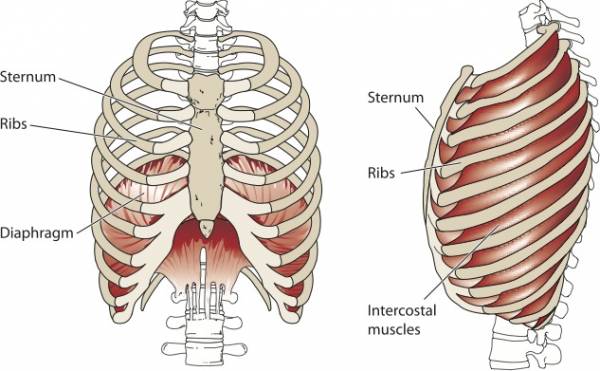It is usually assumed that respiratory muscle performance is ample for most people undertaking endurance sports like cycling. However, studies have shown that in some cases performance can be improved by suitable respiratory training.
In my own experience, many people could also benefit from some simple exercises to improve activation of the diaphragm, because when performing at a high intensity, the ability to supply oxygen and remove waste product via respiration will affect your performance no matter how much strength work you have done previously.
The diaphragm is a huge, dome-shaped muscle at the bottom of the rib cage. Although it is used 24/7, it goes largely unnoticed (unless you get hiccoughs). When the diaphragm contracts, in conjunction with the intercostal muscles, it lowers the pressure in the thoracic cavity. This enables air to enter the lungs.
When breathing out, the diaphragm relaxes along with the intercostal muscles, allowing air to leave. Air may be forced out faster by increasing abdominal pressure using the tranverse abdominis muscle.
The diaphragm also has an important role in stabilizing the core. It forms the top of the core ‘box,’ working with the internal and external obliques, quadratus lumborum, pelvic floor, and transverse abdominus.
The diaphragm has multiple origins from the inner surfaces of the seventh through twelfth ribs, medial parts of the L1 to L3 vertebral bodies, the anterior longitudinal ligament, posterior surface of the xiphoid process, and the arcuate ligament, connecting to the aorta, psoas, and QL to insert in the central tendon. To put it simply, a strong box needs a secure lid and hence the importance of the diaphragm in core stabilization.
 In spite of the diaphragm’s importance in respiratory effectiveness and stabilization of the core, I would estimate that in my experience approximately half of the adult population does not recruit this muscle properly at the beginning.
In spite of the diaphragm’s importance in respiratory effectiveness and stabilization of the core, I would estimate that in my experience approximately half of the adult population does not recruit this muscle properly at the beginning.
When we breathe, this dome-shaped muscle contracts allowing a reduced pressure in the upper body so that air may enter the lungs and provides tension across the top of the abdominal area. As we breathe in, we should see the stomach rise slightly as the dome contracts and compresses the abdominal space. As we breathe out, both the chest and the stomach fall. If you look at young children, this is what you usually see.
I often see exactly the opposite in adults. Their chest rises as the intercostal muscles contract. Yet, the stomach is drawn in by activation of the tranverse abdominis muscle and the diaphragm is not engaged. Whilst this might present a more pleasing profile in a mirror, it reduces the volume of oxygen available by only partially expanding the lungs. This also results in weaker core stabilization.
Over time, breathing in this way will cause the diaphragm to weaken through poor recruitment and performance will suffer. And when I say performance, I mean this both from a respiratory and functional perspective.
This video gives a 3D demostration of proper breathing and the action of the diaphragm:
Whilst a number of lung exercise devices are on the market, it is important to ensure that the diaphragm is recruited properly in the first place. Otherwise, the situation is exacerbated.
There are a also number of simple exercises, requiring no equipment, to assist and strengthen the diaphragm. Here is one for you to try:
- Lie on the floor face up with knees slightly bent.
- Place a small pillow under the head if that is more comfortable for you.
- Place your hands lightly on your stomach.
- Concentrate on breathing using the diaphragm, not using the chest, and feeling the stomach rise as the lungs fill from the bottom.
- Let the stomach fall naturally when breathing out by relaxing the diaphragm.
- Progress by placing a small weight on the stomach, such as a small book, on do it all again.
- The next stage is to stand up and place your hands on your stomach again, feeling how you breathe. Surprisingly, you may find this step requires some concentration initially.
- Finally, practice breathing correctly whilst on the bicycle.
You may find it interesting to observe how a young child breathes. Unhindered by the desire to hold the stomach firmly in, and keeping the diaphragm extended whilst looking in the mirror, they usually have got it right.
References
1. Gething A.D, Williams M, Davies B. Inspiratory resistive loading improves cycling capacity: a placebo controlled trial. Br J Sports Med. 2004 Dec;38(6):730-6.
2. Lee M. Romer and Michael I. Polkey, Exercise-induced respiratory muscle fatigue: implications for performance, Journal of Applied Physiology March 2008 vol. 104 no. 3 879-888






